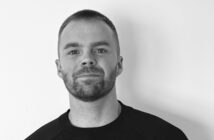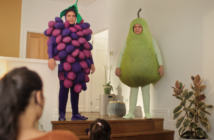After nine years at TBWA, Andy Blood, one of the industry’s most awarded, respected and well-liked creative directors, is handing the reins to Toby Talbot. How’s that for disruption.
On the beginning: “I had five years at Saatchi & Saatchi and then two years in Singapore and I got a phone call out of the blue from Devo one day in 2004 asking me to help take the agency up a notch. It was a bit of a wildcard agency, renowned for having ASB and the Chancery scenario, so it was a risk for me to take the job. Before that I had worked at RKCR Y&R and helped take it from six staff to 75 in a few years. So it was like going back to a start-up. From memory, we had six creatives when I started at TBWA. So to get to this point now means a lot to me. I was also a shareholder and partner, so I had more invested in this business than I’ve ever had before and I got more rewards than I’ve ever had too, not just financially, but because we got to do some amazing work.”
On Devo: “I think we were a huge complement to each other. We had words now and then. Who doesn’t? But we’ve almost never fought. I’d say he’s backed me 1000 percent. He’s a great character, one of the last remaining industry icons, and even when he probably should’ve been protecting his reputation, he’d still speak his mind. But he conducted himself with aplomb. His line is that he values the quality of audacity and he wanted the agency to be a place where mavericks thrived. I think that’s an amazing thing to value. And I think it made him a really brilliant leader … There’s a lot of noise about getting on the wrong side of Devo, but I’ve never really seen it.”
On the glory years: “I think everything we did between 2005 and 2009 was ahead of its time. Absolut Ingenuity, Be the Ball, Bonded by Blood, adiThread. They had a touch of genius about them. All the people here at that time got to execute their best ideas and there was a real meshing of the real world with online. To get the right minds, the right people, and the right brands at the right time is a really rare phenomenon. And the great clients, like Craig Waugh from Adidas, Jono Simons from ASB and Larrie Moore from 2degrees deserve a lot of respect for being brave … Getting things humming at an agency is definitely a case of good fortune, but good fortune is made through a whole lot of work.”
On the management switch: “It’s brilliant, like musical chairs. It’s a great story, and a great talking point, but nobody got marched out of the building, which we’ve all seen happen before in other agencies. Devo was open about the succession plan, so I think it has been handled really well. I don’t read any of the blogs any more. I get enough character assassination here at work and at home. But my partner showed me some of the commentary, and I think I came out of it pretty well.”
On Toby Talbot: “We’ve talked about working together before. And we’ve been good mates for a long time. Even going back to copywriting college in the UK, he came in to speak to the class as a young graduate. He’s also coming back from my old agency, RKCR Y&R, where he worked with a very influential creative director of mine, Mark Roalfe. We are quite different. He definitely has a strength in TV. But that’s important in New Zealand. Most people will get to see your ad on TV here. And people still embrace the great commercials, like Lotto’s Lucky Dog, which has been running for about three years, or the Mitre 10 Sandpit kids, because of what they say about us. Around the world, the leading agencies need to do great film and great digital.”
On the journey:“All the best work I’ve been involved with has been an adventure. It’s not just sitting in a room coming up with ideas. It’s physical. It’s an experience. And when that’s the case you walk away from the work with something that’s somehow deeper and real … Apple’s ‘Here’s to the Crazy Ones’, and Adidas’ ‘Impossible is Nothing’. Both of those are on my wall at home and I look at them every day. And when you get it right, and when it attracts people from inside and outside, that’s when [advertising]transcends every label and becomes among the most powerful and potent things we can do. Like religion, sport, music, film or art, brands can really touch people.”
On home: “After 15 years here I feel absolutely a part of the fabric of the nation and I’m proud and humbled to have worked on some of the most iconic Kiwi brands. I’ve worked with the All Blacks for seven years, on Speight’s and Steinlager [at Saatchi & Saatchi], Tourism New Zealand for the past few years and then we gave birth to a new one with 2degrees. I haven’t had a crack at Air New Zealand though … I actually have a birthmark on the back of my head that looks like the north and south islands and kids in the playground used to say ‘that’s New Zealand’. So maybe it was meant to be … In the ‘90s, New Zealand was famous for New Zealand creative directors doing very Kiwi TV work. And the 2000s was often about the expats doing very Kiwi stuff … Speight’s pub, Yellow Treehouse, Iggy Pop, these were the standard for global campaigns and they were all Grand Prix winners. That was an incredible time for the New Zealand industry.”
On balance: “I think you need an escape hatch from the industry. It’ll kill you if you let it.”
On normal: “I think there was an explosion of innovation in digital in 2008-2009. But that’s slowed down now. It’s human nature to play with all the tools in a new toolbox. But now digital is universal, ubiquitous. It’s the new state of play. YouTube started off being seen as a copyright infringer, and Facebook and Twitter have become an integral part of the paid media system. We thought the model would change and that interruption was dead. But interruption is evident in all these new platforms. Advertising just ate all the new babies.”
On goals: “In 2004, we wanted the agency to be top ten in size and top five creatively. We had only won one international award between 1997 and 2004. And now we’re the only Kiwi agency to have won two Cannes Grand Prix. So I think we’ve achieved those goals … I think one of the best things the agency did was buy Shift in 2007. There’s a quality of digital thinker there you don’t get anywhere else. And it’s a non-agency view of digital. So, along with Tequila, we had two great digital agencies. And putting them together into the Digital Arts Network has been a great decision.”
On hardship: “There have been some incredibly painful times. 2009-2010, when we lost ASB. Holding on to a company through a recession is really, really hard work. And saying goodbye to people who put their lives into what they did for you is an awful thing to have to do. But it was necessary at the time.”
On next:“It’s unlikely I’ll be a man of leisure. I love making things and a creative mind never stops. It’s always thinking, looking for projects, things to explore. I love the process, the meeting of minds, and having something to hold up at the end of it. But because I agreed to keep quiet [after resigning last year], I haven’t been actively marketing myself at all. I’ve been talking to an Australian agency, and TBWA want me to do a regional gig. They said there’s too much of you in us, and vice versa, so that’s really flattering. It’s an amazing prospect, but I’d have to leave New Zealand to do it and I’m not sure I’m ready to do that. I’m 46, so if I want to set up my own agency, it might take a year to get going and five years to pay off [he now has his own consultancy Blood and Sand]. But I am interested in trying to run a global business from here. Basically, I’m going to look at every single option and reject 99 percent of them. It’s a great situation to be in. And if you can walk out of your job on good terms with all your clients and all your colleagues, I think it opens more doors. Not Mordor. More doors.”
- This article originally appeared in the March/April edition of NZ Marketing magazine. Get you sub here.




